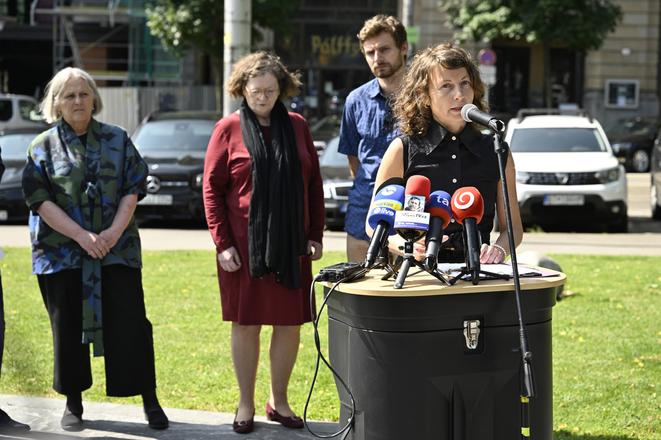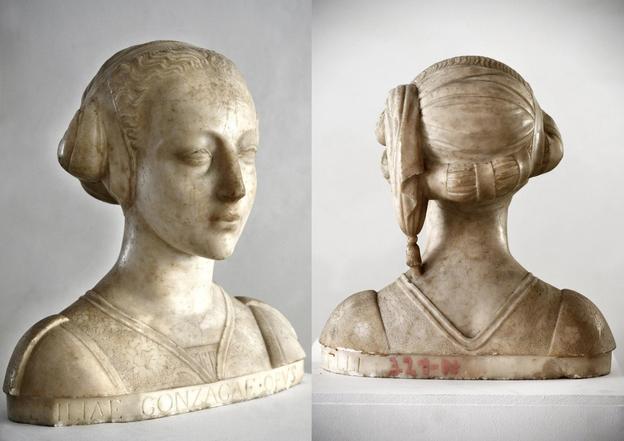In late May, a marble bust believed to be the work of Renaissance master Donatello was quietly removed from the depository of the Spiš Museum in Levoča, eastern Slovakia. It was later revealed that the bust, depicting Cecilia Gonzaga, had been transported to the Interior Ministry’s premises in Topoľčianky, western Slovakia.
Lukáš Machala, Secretary General at the Culture Ministry – who is already under public scrutiny for his perceived role in weakening Slovak cultural institutions – was present during the relocation.
The move has prompted criticism from cultural experts and members of the public alike, who are now calling for an investigation and the immediate return of the bust to the Spiš Museum.
Breach of law
Speaking at a press conference held by the Otvorená Kultúra (Open Culture) platform on Monday, experts claimed that several laws were breached in the course of the bust’s relocation.
“To this day, no contract, invoice or other documentation related to the shipping company involved has been disclosed. This raises questions about who financed the transport and for what purpose,” said anthropologist Ivana Rumanová, as quoted by the Sme daily. She added that it remains unclear who is currently ensuring the legal and professional protection of the bust.
Rumanová also noted that the Culture Ministry can only assume responsibility for the protection of museum collection items under exceptional circumstances – such as war, natural disasters, or fire. These conditions, she said, clearly do not apply in this case. Other exceptions, such as loans for exhibitions, international research, or conservation, have also not been cited.
It was later revealed that the bust was moved to a “highly secure location” and that international experts from Italy will be consulted to confirm its attribution to Donatello.
Rumanová noted that according to Culture Ministry Deputy Minister Tibor Bernaťák, the museum did not sign a formal contract, only an acceptance protocol. However, Rumanová argued that such a protocol forms only part of a proper contract and has no legal weight on its own. She stressed that no official safekeeping agreement exists either, despite the ministry’s claims of a custodial arrangement.
“This is unacceptable,” she said, calling on the General Prosecutor’s Office and relevant oversight and judicial bodies to investigate the matter. “This is not only about an exceptional piece of art, but about setting a dangerous precedent for other collection items across Slovakia.”
Ministry says there is no scandal
In response, the Culture Ministry denied all accusations, dismissing them as “false claims and misleading interpretations”.
“Today, as in the past, we are witnessing the spread of deliberate half-truths and lies, which have already been publicly refuted,” said ministry spokesperson Petra Bačinská in a statement cited by the TASR newswire.
The ministry further accused the Open Culture platform of manufacturing a scandal rather than encouraging professional debate.
However, the bust was also discussed by the parliamentary committee for culture on June 5. MPs noted that a few years ago, the famous Venus of Věstonice was transported in the Czech Republic as part of a publicly announced event. They questioned why the Slovak Culture Ministry failed to immediately explain the reason for and manner of the Donatello bust’s relocation.
Bernaťák said the bust was transported in secret for “tactical reasons”, citing the highly tense social climate and the potential threat to the artwork. “If we lived in normal times and a normal society, there would be no reason to hide it. But right now, any number of incidents could have occurred if the move had been announced in advance,” he said, as quoted by Denník N. The deputy minister also admitted that he himself had not been informed about the transport.
Members of the parliamentary culture committee also wanted to know whether the artwork had been properly insured during transport. According to those present, the bust was not insured separately. Only the specialised transport company had insurance coverage, and its policy was arranged in Austria.
A word of warning
The press conference also featured a statement from Vienna-based Professor Moritz Csáky, a descendant of the family that owned the bust before 1945.
The Csáky noble family settled in Spiš in the 17th century, later building a Neo-Baroque manor in Spišský Hrhov in the late 19th century. A bust of Cecilia Gonzaga was once displayed there. The family fled in 1945, and the bust entered the Spiš Museum in the 1970s. After the Velvet Revolution, contact was restored, with Moritz Csáky and his son returning to the region.
Csáky thanked the museum for its stewardship of the artwork and issued a warning against politicising heritage items.
“I caution against turning individual artefacts into tools for political or commercial games. These objects are not the property of any state institution, ministry, or individual, and must not be handled arbitrarily,” he stated, as quoted by Sme.
He also expressed hope that the bust will return to Levoča, where he believes it belongs. A petition has been launched calling for the bust’s return to Levoča.


 Anthropologist Ivana Rumanová in front. (source: TASR)
Anthropologist Ivana Rumanová in front. (source: TASR)
 A marble bust believed to depict Cecilia Gonzaga is thought to be the work of Renaissance master Donatello.
A marble bust believed to depict Cecilia Gonzaga is thought to be the work of Renaissance master Donatello.